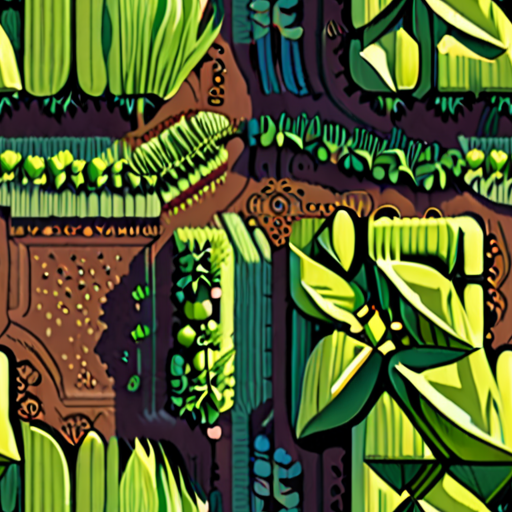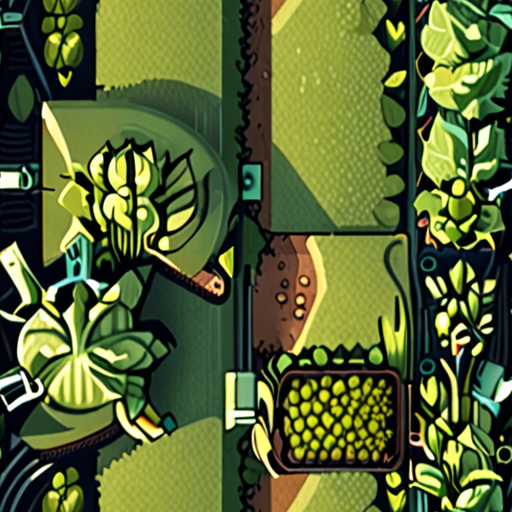As the world grapples with the challenges of climate change, food security, and environmental degradation, the importance of sustainable crop planning cannot be overstated. By adopting innovative and eco-friendly farming practices, farmers can not only reduce their ecological footprint but also increase crop yields, improve soil health, and enhance biodiversity. In this article, we will delve into the world of crop planning for sustainability, exploring the latest strategies and techniques that farmers can use to create a greener tomorrow.
How to Make Crop Production Sustainable
I’m passionate about cultivating a greener future through sustainable agriculture, and I’d love to share my knowledge with you.
-
Sustainable Practices
Implementing sustainable practices in crop production can have a significant impact on the environment and our communities. Some effective methods include:
- Reducing water usage through efficient irrigation systems and mulching
- Minimizing chemical inputs by adopting integrated pest management (IPM) techniques
- Rotating crops to maintain soil health and reduce erosion
- Using cover crops to enhance biodiversity and suppress weeds
-
Heirloom Gardening
Heirloom gardening is a great way to promote genetic diversity and preserve traditional varieties. By saving seeds from open-pollinated plants, we can ensure the continuation of these unique cultivars.
- Choose heirloom varieties that are well-suited to your climate and growing conditions
- Save seeds from healthy, disease-free plants to maintain their integrity
- Share seeds with fellow gardeners to promote community engagement and knowledge sharing
-
Regenerative Agriculture
Regenerative agriculture focuses on rebuilding soil health, conserving water, and sequestering carbon. This approach can lead to improved crop yields, increased biodiversity, and enhanced ecosystem services.
- Use no-till or reduced-till methods to minimize soil disturbance
- Add organic amendments like compost or manure to enhance soil fertility
- Incorporate cover crops and green manures to promote soil biota
- Monitor and manage soil moisture levels to optimize water use efficiency
By incorporating these sustainable practices into your crop production routine, you’ll not only contribute to a healthier environment but also enjoy numerous benefits for your farm or garden.
At Old Seed , we’re dedicated to helping you grow a greener future through education, community engagement, and innovative solutions.
What are the 3 Ps of Sustainable Agriculture?
Sustainable agriculture is a holistic approach to farming that prioritizes environmental stewardship, social responsibility, and economic viability.
- People
- Fair labor practices and safe working conditions
- Access to education, training, and resources for farmers
- Support for local food systems and community development
- Planet
- Soil conservation and regeneration through organic farming practices
- Water management and efficient irrigation systems
- Biodiversity conservation and ecosystem services
- Profit
- Diversified income streams through value-added products and services
- Market access and fair pricing for farmers
- Investment in research and development for innovative solutions
The “people” aspect of sustainable agriculture focuses on the well-being of farmers, farmworkers, and local communities.
The “planet” aspect of sustainable agriculture emphasizes the importance of preserving natural resources and minimizing environmental impact.
The “profit” aspect of sustainable agriculture recognizes the need for financial sustainability and profitability in order to support long-term ecological and social goals.
By balancing these three interconnected aspects, sustainable agriculture can promote a healthier environment, stronger communities, and more resilient food systems.
Crop Sustainability
Crop sustainability refers to the ability of crops to thrive in harmony with the environment, minimizing harm to ecosystems and conserving natural resources for future generations. As an advocate for heirloom gardening and sustainable agriculture, I believe that adopting sustainable practices is crucial for ensuring the long-term health of our planet.
Key Principles of Crop Sustainability
To achieve crop sustainability, we must adhere to several key principles:
- Soil Conservation: Protecting soil health through reduced tillage, cover cropping, and organic amendments helps maintain its fertility and structure.
- Water Efficiency: Implementing drip irrigation systems and mulching reduces water waste and minimizes evaporation.
- Biodiversity: Planting diverse crop rotations and incorporating companion planting promotes ecological balance and resilience.
- Pest Management: Using integrated pest management techniques, such as biological control and cultural controls, reduces chemical pesticide use.
- Climate Change Mitigation: Adopting climate-resilient crop varieties and implementing agroforestry practices helps sequester carbon and reduce greenhouse gas emissions.
Benefits of Sustainable Crop Practices
By embracing sustainable crop practices, farmers can enjoy numerous benefits, including:
- Increased Yields: Sustainable practices promote healthy soil, optimal water usage, and balanced ecosystems, leading to improved crop yields.
- Improved Water Quality: Reduced chemical runoff and efficient water use minimize the impact on local waterways.
- Enhanced Biodiversity: Diverse crop rotations and conservation tillage support beneficial insects, pollinators, and wildlife habitats.
- Reduced Greenhouse Gas Emissions: Climate-resilient crop varieties and agroforestry practices contribute to a lower carbon footprint.
- Increased Farmer Resilience: Sustainable practices enable farmers to adapt to changing weather patterns, market fluctuations, and economic pressures.
Realizing Crop Sustainability
As a gardener and farmer, I recognize that achieving crop sustainability requires a multifaceted approach. By combining these key principles and benefits, we can work towards a more resilient, productive, and environmentally conscious food system. At Old Seed, we’re committed to sharing knowledge, resources, and expertise to empower growers and promote sustainable agriculture practices.
Building a Sustainable Farm Plan
To create a thriving and environmentally conscious farm, it’s essential to develop a well-planned strategy that incorporates sustainable farming techniques.
-
Assess Your Resources
Evaluate your land, climate, soil type, and available water resources to determine the most suitable crops and livestock for your farm.
-
Diversify Your Crops
Plant a variety of crops to promote biodiversity, reduce pests and diseases, and increase crop yields.
-
Implement Conservation Tillage
Reduce soil erosion and retain moisture by minimizing tillage and using cover crops.
-
Use Organic Fertilizers
Avoid synthetic fertilizers and opt for natural alternatives like compost, manure, or green manure to promote soil health.
-
Conserve Water
Implement efficient irrigation systems and use rainwater harvesting techniques to minimize water waste.
-
Integrate Livestock
Raise animals that complement your crops, such as chickens for pest control or cattle for manure fertilizer.
-
Maintain Records
Keep track of weather patterns, soil conditions, and crop yields to refine your farm plan and make informed decisions.
-
Monitor and Adapt
Regularly inspect your farm and adjust your plan as needed to ensure long-term sustainability and success.
By incorporating these sustainable farming techniques into your plan, you’ll be well on your way to creating a thriving and environmentally conscious farm.
Creating a Sustainability Plan
As someone who values environmentally friendly gardening techniques and heirloom seed preservation, I understand the importance of having a well-planned approach to sustainability.
- Step 1: Assess Your Current Practices
- Step 2: Set Clear Goals and Objectives
- Step 3: Develop a Comprehensive Plan
- Step 4: Monitor Progress and Adjust
Determine what aspects of your gardening routine can be improved upon, such as water usage, waste management, and soil health.
Establish specific, measurable targets for reducing your environmental impact, such as decreasing water consumption by 20% or increasing biodiversity by 30%.
Create a detailed roadmap outlining the actions needed to achieve your goals, including implementing rainwater harvesting systems, composting, and crop rotation.
Regularly track your progress, making adjustments as necessary to stay on course and overcome any challenges that arise.
Key Considerations for a Sustainable Garden
When developing your sustainability plan, keep the following factors in mind:
- Water Conservation
- Sustainable Soil Management
- Biodiversity and Ecosystem Services
- Waste Reduction and Recycling
Implement efficient irrigation systems, collect rainwater, and reduce evaporation through mulching and cover cropping.
Use organic amendments, maintain optimal pH levels, and incorporate cover crops to enhance soil fertility and structure.
Incorporate a variety of plants, including native species, to support local pollinators and beneficial insects, and promote ecosystem resilience.
Compost food scraps, reuse materials whenever possible, and minimize packaging waste to reduce your garden’s ecological footprint.
Resources for Sustainable Gardening
For further guidance and inspiration, explore the following resources:
- USDA Natural Resources Conservation Service
- Environmental Protection Agency – Sustainability
- Permaculture Australia
How Many Acres for a Self-Sustaining Farm?
The ideal size of a self-sustaining farm depends on several factors, including the type of crops and livestock being raised, climate, soil quality, and available water resources.
- Crop Production: A small-scale farm can start with around 10-20 acres of land, focusing on intensive crop production using techniques like permaculture and biodynamics.
- Livestock Grazing: For a larger operation, 50-100 acres may be needed to accommodate grazing animals like cattle, sheep, or goats, depending on the breed and management practices.
- Combining Crops and Livestock: A balanced approach might require 25-40 acres for a mix of crops and livestock, allowing for rotational grazing and efficient use of resources.
When planning a self-sustaining farm, consider the following principles:
- Diversify Crops and Livestock: Grow a variety of fruits, vegetables, grains, and legumes, and raise multiple types of livestock to minimize reliance on external inputs.
- Implement Efficient Water Management: Use rainwater harvesting, greywater systems, and drought-resistant crops to conserve water and reduce waste.
- Build Soil Health: Employ regenerative agriculture practices like cover cropping, composting, and minimal tillage to maintain fertile soil and promote ecosystem services.
- Design for Resilience: Incorporate features like windbreaks, shelterbelts, and wildlife corridors to mitigate climate-related risks and support biodiversity.
A well-designed self-sustaining farm can thrive on a smaller acreage, making efficient use of resources and minimizing environmental impact.
Key Considerations for Small-Scale Farms:
For those just starting out, consider the following:
- Start Small: Begin with a manageable plot size and gradually expand as experience and resources grow.
- Choose Drought-Tolerant Crops: Select varieties that require less water and can thrive in challenging conditions.
- Invest in Efficient Irrigation Systems: Implement drip irrigation or other low-water technologies to optimize water use.
- Develop a Long-Term Plan: Set realistic goals and timelines for expanding operations and achieving self-sufficiency.
Conclusion:
A self-sustaining farm requires careful planning, attention to detail, and a commitment to long-term sustainability. By understanding the ideal acreage for various farm configurations and implementing efficient practices, farmers can create thriving ecosystems that support both people and the planet.





0 Comments